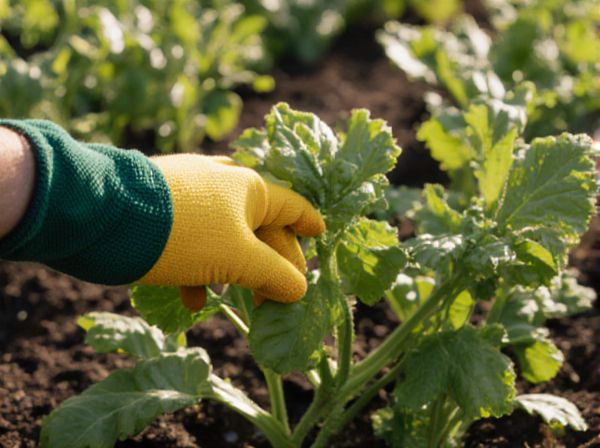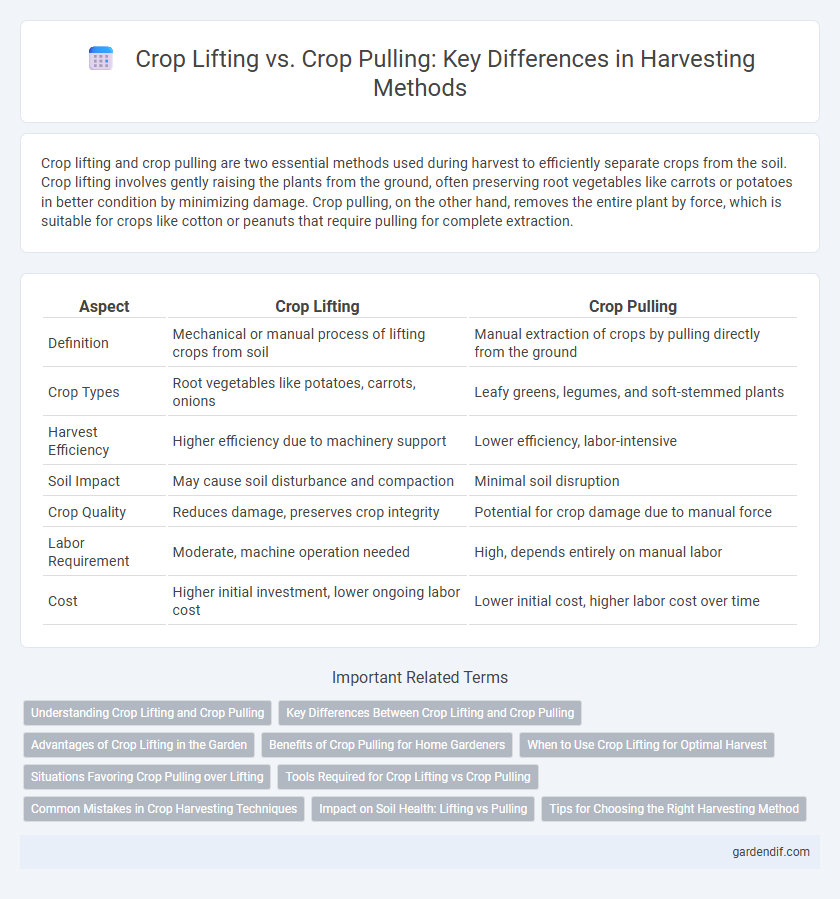
Crop Lifting vs Crop Pulling Illustration
Crop lifting and crop pulling are two essential methods used during harvest to efficiently separate crops from the soil. Crop lifting involves gently raising the plants from the ground, often preserving root vegetables like carrots or potatoes in better condition by minimizing damage. Crop pulling, on the other hand, removes the entire plant by force, which is suitable for crops like cotton or peanuts that require pulling for complete extraction.
Table of Comparison
| Aspect | Crop Lifting | Crop Pulling |
|---|---|---|
| Definition | Mechanical or manual process of lifting crops from soil | Manual extraction of crops by pulling directly from the ground |
| Crop Types | Root vegetables like potatoes, carrots, onions | Leafy greens, legumes, and soft-stemmed plants |
| Harvest Efficiency | Higher efficiency due to machinery support | Lower efficiency, labor-intensive |
| Soil Impact | May cause soil disturbance and compaction | Minimal soil disruption |
| Crop Quality | Reduces damage, preserves crop integrity | Potential for crop damage due to manual force |
| Labor Requirement | Moderate, machine operation needed | High, depends entirely on manual labor |
| Cost | Higher initial investment, lower ongoing labor cost | Lower initial cost, higher labor cost over time |
Understanding Crop Lifting and Crop Pulling
Crop lifting involves mechanically raising crops from the ground, allowing for efficient harvesting of root vegetables like potatoes or carrots without damaging them. Crop pulling, on the other hand, entails extracting plants by their roots, commonly used for crops such as onions and peanuts, which require careful removal to maintain quality. Understanding the differences between crop lifting and crop pulling helps optimize harvesting methods based on crop type, soil conditions, and desired produce quality.
Key Differences Between Crop Lifting and Crop Pulling
Crop lifting involves gently raising the crop from the soil without removing the entire plant, preserving root structures for potential regrowth or soil stability, whereas crop pulling entails uprooting the entire plant including roots, which can disrupt the soil and reduce future soil health. Crop lifting is typically used for crops like potatoes and carrots to minimize damage and maintain product quality, while crop pulling is common for crops that are harvested entirely, such as sugar beets and certain root vegetables. Understanding these techniques helps optimize harvest efficiency, crop yield, and soil conservation strategies in modern agriculture.
Advantages of Crop Lifting in the Garden
Crop lifting preserves root integrity and minimizes plant damage, leading to higher-quality harvests and longer shelf life for vegetables like carrots and potatoes. It reduces soil compaction and allows for more efficient collection, improving overall garden productivity. Enhanced aeration and nutrient retention from lifting promote healthier regrowth in subsequent planting cycles.
Benefits of Crop Pulling for Home Gardeners
Crop pulling offers home gardeners greater control over the harvest timing, ensuring fruits and vegetables are picked at peak ripeness for optimal flavor and nutritional value. This method minimizes plant damage and reduces the risk of soil compaction compared to crop lifting, promoting healthier soil structure and sustained plant growth. Crop pulling also allows for easier cleanup and management of garden space, enhancing overall garden efficiency and yield.
When to Use Crop Lifting for Optimal Harvest
Crop lifting is ideal for root crops like potatoes, carrots, and onions when soil moisture is balanced to prevent damage and ensure clean extraction. Use crop lifting after crop maturity but before excessive soil drying or rainfall to minimize bruising and spoilage. This method enhances harvest quality by preserving the integrity of delicate tubers and roots, improving storage longevity and market value.
Situations Favoring Crop Pulling over Lifting
Crop pulling is favored over crop lifting in delicate harvest scenarios where minimizing damage to the produce is critical, such as with root vegetables like carrots and beets. It allows for selective extraction, preserving soil structure and reducing mechanical stress on both crops and equipment. This method proves particularly advantageous in uneven or rocky terrains where lifting machinery may struggle or cause excessive wear.
Tools Required for Crop Lifting vs Crop Pulling
Crop lifting requires specialized tools such as mechanical lifters or elevators designed to gently uproot and transport crops like potatoes or carrots without damaging them. Crop pulling relies more on manual or basic mechanized tools like forks, spades, or simple lifting devices to extract plants by their stems or roots, suitable for crops like sugar beets or cotton. The choice of tools depends on the crop type, soil condition, and desired harvesting efficiency, with lifting tools prioritizing minimal crop damage and pulling tools focusing on extraction speed.
Common Mistakes in Crop Harvesting Techniques
Common mistakes in crop harvesting techniques include improper crop lifting and crop pulling methods that lead to damage and reduced yield quality. Crop lifting requires precise mechanical adjustment to avoid bruising and root breakage, while crop pulling often results in soil contamination and increased post-harvest loss. Understanding the crop-specific harvesting requirements and using the right machinery can minimize these issues and improve overall harvest efficiency.
Impact on Soil Health: Lifting vs Pulling
Crop lifting minimizes soil disturbance by gently removing crops with their roots intact, preserving soil structure and reducing erosion risks. Crop pulling often disrupts soil composition, leading to increased compaction and loss of essential organic matter. Maintaining soil health is critical for sustainable yield, making crop lifting a preferred method for long-term agricultural productivity.
Tips for Choosing the Right Harvesting Method
Selecting the appropriate harvesting method depends on crop type, soil conditions, and intended use; crop lifting preserves root integrity and reduces damage, ideal for root vegetables like carrots and potatoes. Crop pulling suits crops with loose soil attachment, allowing quicker harvest but increasing risk of plant injury and soil disruption. Assess factors such as crop maturity, machinery availability, and post-harvest handling requirements to optimize yield quality and operational efficiency.
Crop Lifting vs Crop Pulling Infographic

 gardendif.com
gardendif.com